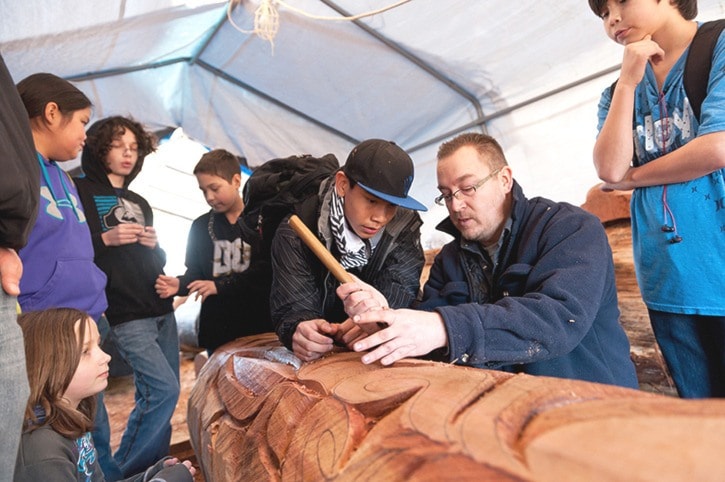PORT HARDY—Students at Fort Rupert Elementary School were presented last year with the gift of a new school logo by Kwakiutl carver Trevor Hunt. Now Hunt is back for a much bigger project, and this time the kids will have a hands-on role.
“We’ll be creating a seven-and-a-half-foot sun mask,” Hunt said as he kicked off his artist-in-residence program in the school Friday. “I’ll be the only one carving, but the kids will help design and paint. I’ve done this before at Wagalus School with a bunch of paddles, and the kids are happy with the end result because they know they’ve painted it.”
Hunt, who descends from a legendary line of Kwakwaka’wakw carvers and artists, Fort Rupert Elementary students one day a week through the end of the school year as part of the Art Starts’ Artist in the Classroom program.
The residency is funded by the British Columbia Arts Council, the Province of British Columbia and School District 85’s Aboriginal Education Department. It kicked off one week earlier with a school field trip to neighbouring Tsaxis (Fort Rupert), where students visited the home of veteran carver Stan Hunt, Trevor’s father, and the salmon smoke house.
On Friday, Hunt returned the favour, visiting the school for the first of a series of sessions that will result in the creation of the intricately carved sun mask and several paddles, which will be placed in the school when finished.
“We’re hoping to get the kids some authentic experiences that they can really connect to their place in Fort Rupert, as members of the community and in line with the tradition of the great art around here,” said Kevin Brand, the school’s second-year principal. “Bringing Trevor in is really the way to do that.”
Hunt is no stranger to working with schoolchildren. He has donated his time to share Kwakiutl cultural heritage and art at Fort Rupert Elementary, at Wagalus School in Tsaxis, and, before it was closed in a cost-cutting measure in 2010, Robert Scott Elementary in Port Hardy.
“I’ve been going down to carve and to try to spark some interest in carving in some of the younger kids,” Hunt said. “I think it’s really good for the kids to learn to design, and learn the formulas of how to put masks together, as well.”
Part of the mandate of the Art Starts’ Program is to connect the art with other curricular areas.
“Writing is the focus we’re bringing into it,” said Brand. “So students did some pre-writing before their field trip, predicting what they might see and what they already know about carving. As they’re creating themselves, they also be incorporating some writings and blogs and that sort of thing.
“We’re planning an online photo journal, co-constructed by Trevor and the kids.”
Hunt’s initial session Friday started at the ground floor, with students in all grade, kindergarten through Grade 7, tracing simple ovoid patterns to get a feel for the flow of design. But he admits his residency is also something of a scouting effort to help maintain Kwakiutl tradition alive.
“Say there’s a hundred kids, and there’s one kid that has that spark, to want to learn how to carve,” he said. “You influence that one kid, and 10, 15 years from now he might be the one carving. That’s all we need, to keep it going, the tradition.”
During the students’ field trip to Stan Hunt’s carving studio, the elder Hunt reinforced that message.
“That’s all part of our job, actually,” said Stan, who in 2012 completed a 42-foot totem pole that was placed in Argentina. “To make sure that one of the kids — it could be two or three, but one at least — will bite and start (carving). You never know; you might have the next Robert Davidson or Rande Hunt.”
